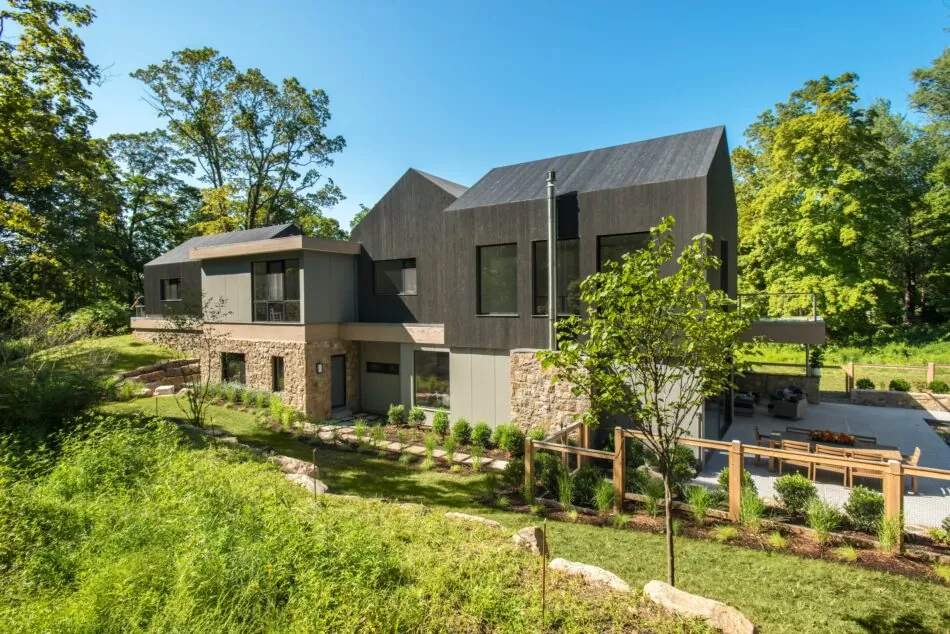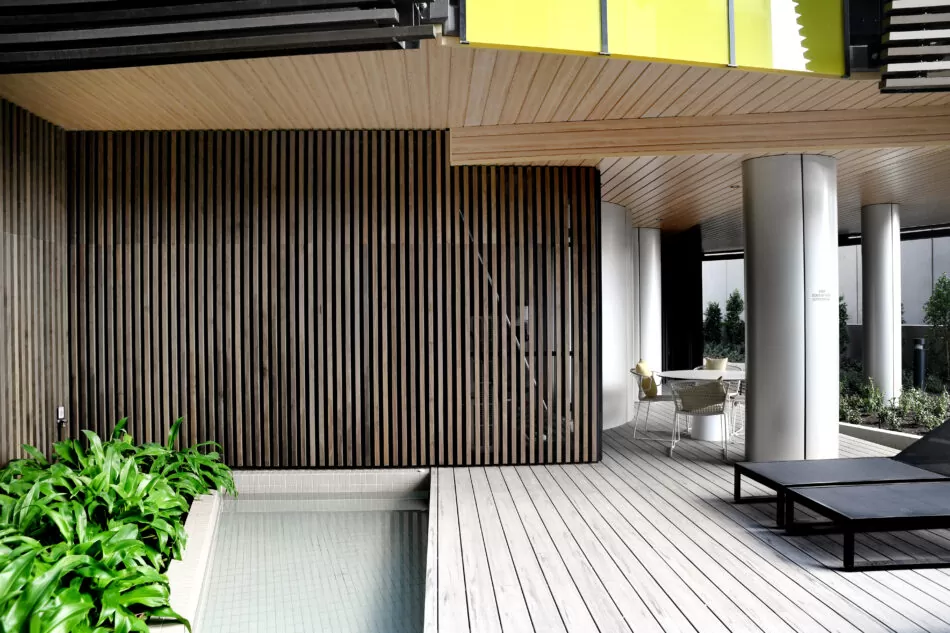
6 On Trend Details to Give your Home Exterior a Fresh Look by HOUZZ
Building a new home or updating your façade? Be inspired by these 6 ways to stylishly warm up the exterior with Accoya wood.
20.12.2021

So much attention is paid to the interiors of our homes, but the exterior is what makes the first impression. A beautifully designed façade enhances the architecture and sets the tone and feel of a home before guests even set foot inside. With its warm, natural appeal and virtually limitless design potential, wood cladding has emerged as a major trend in exteriors. Here are six of-the-moment ways to use it to give your property serious street appeal.

1. Opt for a Beautifully Weathered Façade
Embrace the natural look with untreated wood cladding that ages gracefully over time. It’s a wonderful way to highlight the earthy and organic beauty of the wood, and helps a home blend in with the landscape.
This stunning lakeside home in Saint Joseph, Michigan, called for a hardy wood cladding that could withstand the constant wind coming off Lake Michigan. Accoya cladding was chosen for its sustainability, durability and superior resistance to weather and rot. Leaving the wood untreated has allowed it to develop a stunning natural appearance that merges with the earthy, natural setting, while creating a pleasing contrast against the home’s sharp black window frames.

While standard wood cladding has its benefits, it’s not suitable for every project or homeowner, as it requires ongoing maintenance and can deteriorate over time. Today you’ll find innovative alternatives that provide all the warmth and natural appeal of wood, with minimal maintenance requirements and far superior durability. Accoya’s acetylated wood cladding can withstand even tough weather conditions, is resistant to rotting, and if left untreated will weather naturally to a beautiful silvery grey.
Accoya wood has impressive environmental credentials too. It’s fully sustainable, and every panel comes with FSC (Forest Stewardship Council) certification. It is also 100 percent nontoxic, so you can have peace of mind knowing it’s a healthy choice for you and your family.

2. Ditch the Trim
Want the focus to be on the shape and form of your architecture rather than individual features such as your windows? Extending your wood cladding right to the window ledges without including a trim, as seen on this home (Ash Tree Residence) in New Canaan, Connecticut, keeps all eyes firmly on the bigger picture while creating a sleek and modern look.
Here, Accoya cladding in Old Town Gray was used to add a modern-rustic feel to the home and highlight the dramatic shape of its gable-roofed entry volume. The large picture windows are trim-free and feature minimalist frames — a clever way to maximize light and views inside the home without overshadowing the bigger architectural story from the outside.

3. Try the Shou-Sugi-Ban Trend
If you’re looking to make a statement with a bold exterior, consider giving your home the shou-sugi-ban treatment. This ancient Japanese technique involves charring the wood to preserve and strengthen it. The charring turns the wood a deep charcoal black while revealing its texture and grain. Not only does this wood treatment make for a striking façade, but it minimizes maintenance.

4. Focus on Natural Materials
As the saying goes, less is more. Choosing one “hero” natural material and using it in different ways across your home’s exterior can be a subtle, but very effective, way to bring cohesion to your home’s design. To create an uninterrupted sense of flow, you could carry the material through to the interior of your home or to any outbuildings.
The key to success when using a single natural material is to be creative with how you apply it. This award-winning boathouse (The Haven) in Norfolk, England, has been given light-tone Accoya wood cladding, decking and curved screening. As the property is surrounded by water on three sides, the architects selected Accoya wood for its water-resistant properties and dimensional stability, as well as its stunning natural looks and sustainability. The result is a graceful home that sits lightly in its tranquil coastal setting.

5. Play Up Textures
Natural appeal aside, wood cladding gives you endlessly creative ways to express your personal style. Take this three-story office building designed and occupied by architectural firm Dillon Kyle Architects in Houston, for example. It’s clad in 2,500 Accoya boards that have an abstract leaf-like pattern carved into the wood. The pattern references the oak trees that line the neighbourhood, and it adds not just texture and softness to the modern structure but a unique personal touch.
“The Accoya wood boards are unsealed and allowed to weather over time,” says Peter Klein, associate principal architect at Dillon Kyle Architects. “The idea was to use a material where you couldn’t tell where the patterns started and stopped — just one big continuous object.”
As the wood cladding would play a pivotal role in the look and performance of the building, the firm took their time choosing the right one. “Even left untreated, it didn’t warp or mildew or mould, and that let us know we were on the right path,” Klein says. “The neutral grey tones coupled with its long-term durability, resistance to rot and insects made Accoya wood the ideal material for this project.”

6. Go Skinny
Add texture and depth to your home’s exterior with narrow boards for cladding, louvers and screening.
For this luxury apartment block (Blackwood Street Apts) in Melbourne, Australia, the architect specified 40-by-40-millimeter Accoya wood boards with a coat of Woca Exterior Walnut Oil for the louvers and screening in the alfresco areas. The oiled boards create a soft and inviting feel while bringing a sense of intimacy to the apartment complex.
The rest of the detailing in this spot, including hardware and pavers, was deliberately pared back to keep the focus firmly on the textural wood.

Running slender boards vertically, as the architect has done here, is a clever design technique for making a low roof or ceiling appear higher. You can use this strategy both outside your home with wood cladding and inside with wood wall lining.
If room height is not a concern, consider mixing vertical and horizontal patterns for added texture and interest inside or outside your home.
More: Learn more about Accoya’s range of sustainable, acetylated wood products by visiting our homepage here.
This story was written by the Houzz Sponsored Content team.
WHERE TO BUY ACCOYA
for your next projectWhat type of Product are you interested in?
- - Select product type -
-
FIND A SUPPLIER
FIND A INSTALLER
for your next projectWhat type of are you interested in? (optional)
How will your be used?
- - Select type -
-
You are currently on the Accoya site
Would you like to visit the Accoya Site to view all relevant content for your location?